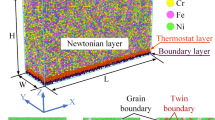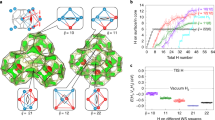Abstract
The interaction between mechanics and chemistry plays an essential and critical role in the behaviors and properties of materials, especially in nanoscale alloys. Based on the classical Gibbs and McLean adsorption isotherms, the present study takes the freestanding nanometer thick films of Pd-H solid solutions as a typic example to investigate surface segregation of hydrogen. The surface eigenstress model is further developed here to give analytic formulas, which have the capability to quantitatively predict the size-dependent surface segregation. Molecular dynamics (MD) simulations are conducted on free-standing Pd-H nanofilms. The MD simulations verify the theoretical analytic results and determine the values of parameters involved in the theoretical analysis. The integrated theoretical and numerical study exhibits that both surface excess H concentration and apparent biaxial Young’s modulus of Pd-H thin films depend on the nominal H concentration and the film thickness. The MD simulations determine the values of three parameters involved in the theoretical analysis. Especially, the parameter of the differentiation in reference chemical potential behaves like the molar free energy of segregation in the McLean adsorption isotherm.
Similar content being viewed by others
References
Cammarata R C. Surface and interface stress effects in thin films. Prog Surf Sci, 1994, 46: 1–38
Ibach H. The role of surface stress in reconstruction, epitaxial growth and stabilization of mesoscopic structures. Surf Sci Rep, 1997, 29: 195–263
Griessen R, Strohfeldt N, Giessen H. Thermodynamics of the hybrid interaction of hydrogen with palladium nanoparticles. Nat Mater, 2016, 15: 311–317
Syrenova S, Wadell C, Nugroho F A A, et al. Hydride formation thermodynamics and hysteresis in individual Pd nanocrystals with different size and shape. Nat Mater, 2015, 14: 1236–1244
Gibbs J. The Scientific Papers. New York: Dover, 1961
Maclean D. Grain Boundaries in Metals. Oxford: Clarendon Press, 1957
Li J C M, Oriani R A, Darken L S. The thermodynamics of stressed solids. Z für Physikalische Chem, 1966, 49: 271–290
Larché F, Cahn J W. A linear theory of thermochemical equilibrium of solids under stress. Acta Metall, 1973, 21: 1051–1063
Zhang T Y, Chu W Y, Hsiao C M. Mechanism of hydrogen induced softening. Scripta Metall, 1986, 20: 225–230
Zhang T Y, Chu W Y, Hsiao C M. Tetragonal distortion field of hydrogen atoms in iron. Metall Trans A, 1985, 16: 1649–1653
Zhang T Y, Hack J E. The equilibrium concentration of hydrogen atoms ahead of a mixed mode I-Mode III crack tip in single crystal iron. Metall Mat Trans A, 1999, 30: 155–159
Larché F, Cahn J W. A nonlinear theory of thermochemical equilibrium of solids under stress. Acta Metall, 1978, 26: 53–60
Chen-Min Li J. Physical chemistry of some microstructural phenomena. Metall Trans A, 1978, 9: 1353–1380
Shuttleworth R. The surface tension of solids. Proc Phys Soc A, 1950, 63: 444–457
Muller P. Elastic effects on surface physics. Surf Sci Rep, 2004, 54: 157–258
Zhang T Y, Luo M, Chan W K. Size-dependent surface stress, surface stiffness, and Young’s modulus of hexagonal prism [111] β-SiC nanowires. J Appl Phys, 2008, 103: 104308
Gurtin M E, Ian Murdoch A. A continuum theory of elastic material surfaces. Arch Rational Mech Anal, 1975, 57: 291–323
Gurtin M E, Ian Murdoch A. Surface stress in solids. Int J Solids Struct, 1978, 14: 431–440
Zhang T Y, Wang Z J, Chan W K. Eigenstress model for surface stress of solids. Phys Rev B, 2010, 81: 195427
Zhang T Y, Ren H, Wang Z J, et al. Surface eigen-displacement and surface Poisson’s ratios of solids. Acta Mater, 2011, 59: 4437–4447
Chan W K, Luo M, Zhang T Y. Molecular dynamics simulations of four-point bending tests on SiC nanowires. Scripta Mater, 2008, 59: 692–695
Chan W K, Zhang T Y. Mechanics analysis and atomistic simulations of nanobridge tests. J Appl Phys, 2010, 107: 023526
Wang Z J, Liu C, Li Z, et al. Size-dependent elastic properties of Au nanowires under bending and tension—Surfaces versus core non-linearity. J Appl Phys, 2010, 108: 083506
Zhou X Y, Ren H, Huang B L, et al. Size-dependent elastic properties of thin films: Surface anisotropy and surface bonding. Sci China Tech Sci, 2014, 57: 680–691
Zhou X Y, Ren H, Huang B L, et al. Surface-induced size-dependent ultimate tensile strength of thin films. Phys Lett A, 2015, 379: 471–481
Zhou X Y, Huang B L, Zhang T Y. Size- and temperature-dependent Young’s modulus and size-dependent thermal expansion coefficient of thin films. Phys Chem Chem Phys, 2016, 18: 21508–21517
Sun H L, Chen L Y, Sun S, et al. Size- and temperature-dependent Young’s modulus and size-dependent thermal expansion coefficient of nanowires. Sci China Tech Sci, 2018, 61: 687–698
Lemier C, Weissmüller J. Grain boundary segregation, stress and stretch: Effects on hydrogen absorption in nanocrystalline palladium. Acta Mater, 2007, 55: 1241–1254
Zhang T Y, Ren H. Solute concentrations and strains in nanograined materials. Acta Mater, 2013, 61: 477–493
Ren H, Yang X, Gao Y, et al. Solute concentrations and stresses in nanograined H-Pd solid solution. Acta Mater, 2013, 61: 5487–5495
Yamauchi M, Ikeda R, Kitagawa H, et al. Nanosize effects on hydrogen storage in palladium. J Phys Chem C, 2016, 112: 3294–3299
Sachs C, Pundt A, Kirchheim R, et al. Solubility of hydrogen in single-sized palladium clusters. Phys Rev B, 2001, 64: 075408
Ingham B, Toney M F, Hendy S C, et al. Particle size effect of hydrogen-induced lattice expansion of palladium nanoclusters. Phys Rev B, 2008, 78: 245408
Zhang T Y, Ren H. Solute concentrations and strains in nanoparticles. J Thermal Stresses, 2013, 36: 626–645
Ren H, Zhang T Y. H concentrations and stresses in Pd nanoparticles. Mater Lett, 2014, 130: 176–179
Lebouin C, Soldo Y, Grigoriev S A, et al. Kinetics of hydrogen sorption by palladium nanoparticles. Int J Hydrogen Energy, 2013, 38: 966–972
Wagner S, Kramer T, Uchida H, et al. Mechanical stress and stress release channels in 10–350 nm palladium hydrogen thin films with different micro-structures. Acta Mater, 2016, 114: 116–125
R D Debiaggi S, Crespo E A, Braschi F U, et al. Hydrogen absorption in Pd thin-films. Int J Hydrogen Energy, 2014, 39: 8590–8595
Swaminarayan S, Srolovitz D J. Surface segregation in thin films. Acta Mater, 1996, 44: 2067–2072
Cahn J W. On spinodal decomposition. Acta Metall, 1961, 9: 795–801
Li Y S, Li S X, Zhang T Y. Effect of dislocations on spinodal decomposition in Fe-Cr alloys. J Nucl Mater, 2009, 395: 120–130
Weissmüller J, Duan H L, Farkas D. Deformation of solids with nanoscale pores by the action of capillary forces. Acta Mater, 2010, 58: 1–13
Weissmüller J, Cahn J W. Mean stresses in microstructures due to interface stresses: A generalization of a capillary equation for solids. Acta Mater, 1997, 45: 1899–1906
Lacher J R. A theoretical formula for the solubility of hydrogen in palladium. Proc R Soc Lond A, 1937, 161: 525–545
Simons J W, Flanagan T B. Absorption isotherms of hydrogen in the α-phase of the hydrogen-palladium system. J Phys Chem, 1965, 69: 3773–3781
Plimpton S. Fast parallel algorithms for short-range molecular dynamics. J Comput Phys, 1995, 117: 1–19
Senftle T P, Janik M J, van Duin A C T. A ReaxFF investigation of hydride formation in palladium nanoclusters via monte carlo and molecular dynamics simulations. J Phys Chem C, 2014, 118: 4967–4981
Nosé S. A molecular dynamics method for simulations in the canonical ensemble. Mol Phys, 1984, 52: 255–268
Martyna G J, Tobias D J, Klein M L. Constant pressure molecular dynamics algorithms. J Chem Phys, 1994, 101: 4177–4189
Parrinello M, Rahman A. Polymorphic transitions in single crystals: A new molecular dynamics method. J Appl Phys, 1981, 52: 7182–7190
Shinoda W, Shiga M, Mikami M. Rapid estimation of elastic constants by molecular dynamics simulation under constant stress. Phys Rev B, 2004, 69: 134103
Yamanaka S, Yoshioka K, Uno M, et al. Thermal and mechanical properties of zirconium hydride. J Alloys Compd, 1999, 293–295: 23–29
Smith R J, Otterson D A. The effect of hydrogen on the tensile properties of palladium. J Less Common Met, 1971, 24: 419–426
Acknowledgments
This work was supported by the National Key R&D Program of China (Grant No. 2017YFB0701604). S. Sun also acknowledges support by the National Natural Science Foundation of China (Grant No. 11672168).
Author information
Authors and Affiliations
Corresponding authors
Rights and permissions
About this article
Cite this article
Cai, H., Mai, J., Gao, Y. et al. Surface segregation of hydrogen in free-standing Pd-H alloy nanofilms. Sci. China Technol. Sci. 62, 1735–1746 (2019). https://doi.org/10.1007/s11431-019-9529-4
Received:
Accepted:
Published:
Issue Date:
DOI: https://doi.org/10.1007/s11431-019-9529-4




